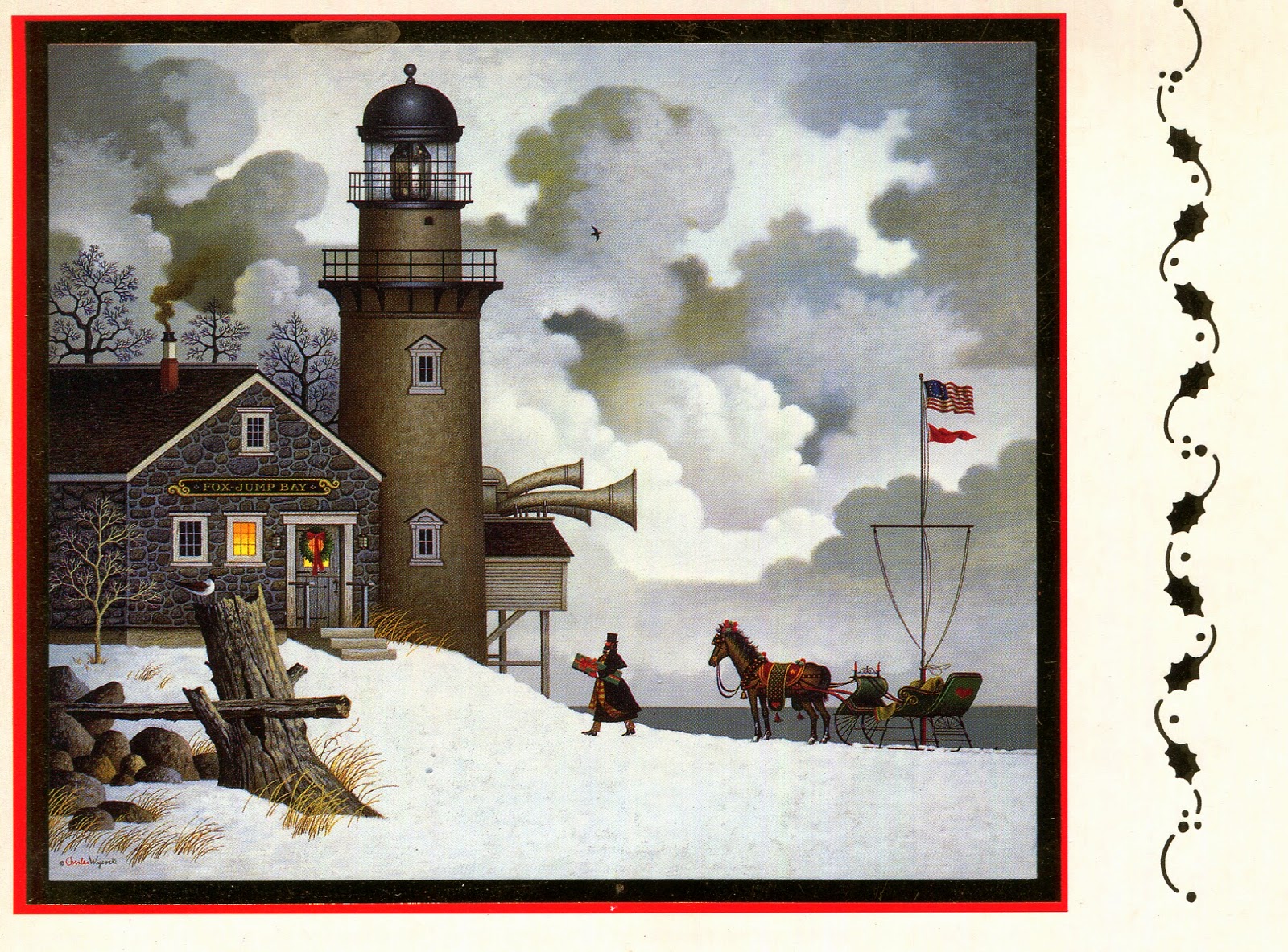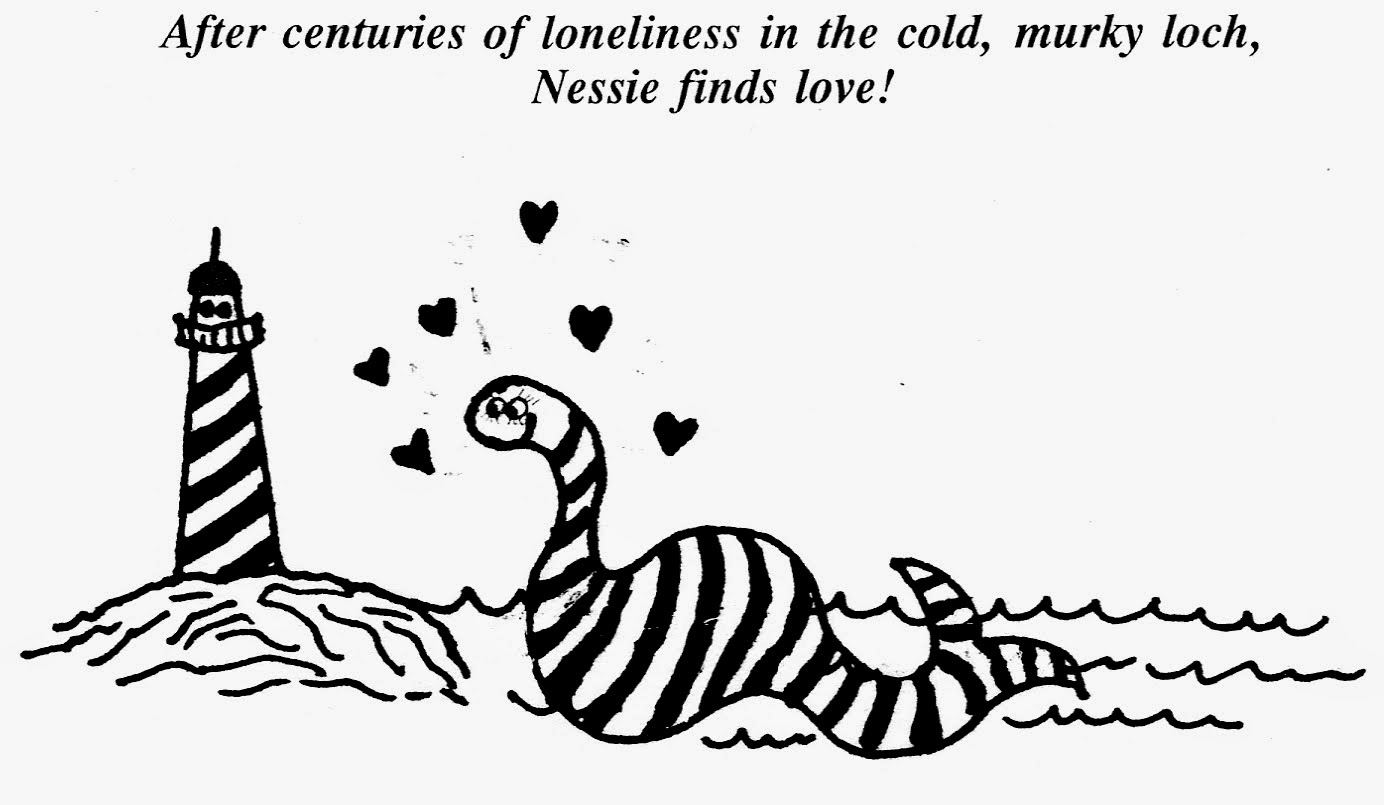I credit a lingering "hunting and gathering" urge for the cache of collectibles in my office, useless but beloved things filling up cabinets and shelves and drawers, hanging on walls and packed away in trunks, in cardboard boxes, and inside plastic see-through tubs. If it has a lighthouse on it, I have it or want it or feel that I desperately need it. I may, single-handedly, keep eBay solvent!
But, unlike the dreaded hoarders we see on a popular but pathetic TV series, I hoard a specific type of item for a specific purpose, and I keep my collection organized and neat. You won't stumble over piles of lighthouse stuff in my house or office or get lost in a morass of meaningless minutia. It's all categorized and maintained in an efficient, almost obsessive-compulsive way. This is how the accumulated lives of passionate people are kept. If I were the Santa Claus of lighthouse stuff, my flying reindeer would be named: Stasher, Amasser, Gleaner, and Snippin, Squirreler, Ferreter, Filer, and Packrat.
The reason my stash is not a hoard is that most of my collection is flat. Call me the Flat Stanley of lighthouse collectors. I like stuff that can be folded, smoothed, laid on a page or in an album, or filed in a box. In the years when my family moved frequently on military assignments, flat collectibles were easy organize and store. They usually were cheap too, and they didn't take up much space or weigh much--important when there were poundage limits imposed for a move to a new duty station.
So, what does a flat lighthouse-themed collection look like? Patches, for starters. Ziploc bags filled with them. I just bought this one a few weeks ago as a sort of remembrance of spring 2014 and many pleasant hours of writing the Itty-Bitty-Kitty Guide to the Lighthouses of New Hampshire. It features Lake Sunapee Lighthouse.
Sometimes I sew my lighthouse patches on shirts or jackets, but I always remove them when the clothing is sent to a donation center and store them...flat. Recently, I went through my lighthouse patch collection and was amazed at the variety of them--Coast Guard units and ships, police and firefighters, city seals, museums, states, and more. At the beginning of this blog is a Boy Scout Council patch. There are at least a half-dozen of these with lighthouses featured.
Lighthouse stamps and cachets store flat. I can hoard scads of them in a small space. And I do! I loved collecting stamps of all kinds when I was a kid, cutting them neatly off the mail that came to our house and pondering their postal travels. People saved stamps for me. My grandmother in Pittsburgh kept a stash of them in an empty sugar bowl in her cupboard and gave them to me when I visited her every summer. A Sunday school teacher I had in Maryland cut them off her mail and doled them out to me on Sunday mornings--maybe as encouragement to attend and as a reward too.
Lately, I buy lighthouse stamps. Here's a set of pretty stamps I bought in Poland a few years ago. They're special to me because I visited all four of these lighthouses, plus many others in Poland. And, these souvenirs came home flat in my suitcase.
I like to collect (hoard?) postcards for the same reason I like stamps and patches. Postcards and patches have travels attached to them. I have a very large collection of lighthouse postcards, stored in shoeboxes. I collect shoeboxes too, not for the shoes that come in them, but for all the flat things I can store inside those boxes! Here's a small sampling of my lighthouse postcards. Every one of them reminds me of a story or a tidbit from history:
Genoa Lighthouse, kept by the uncle of Christopher Columbus--I'd like to think old CC came to love the sea and wonder about what lay beyond the horizon while visiting his uncle Antonio Columbo at this lighthouse.
I love this colorful 1909 postcard of Sand Key Lighthouse in Florida. It's not only a historic look back at the station when it had a dwelling and boathouse on site (before hurricanes destroyed them), but it also it has that wonderfully plump ring of alligators. I'm sure no alligator ever swam out to Sand Key, adrift as it is in saltwater. But Florida tourists love to send postcards with emblems of the Sunshine State...like alligators...and lighthouses.
Here's an old postcard of Cape Disappointment Lighthouse, before it got the big black strip around its middle. You can see the cannons from the fort that encompassed the site and some buildings that are gone now. It's a glimpse back in time. That's the Graveyard of the Pacific behind it at the mouth of the Columbia River. The ship that brought building materials for this lighthouse actually sank right off the site. If that doesn't underscore the need for a lighthouse, nothing does! I've stood on this bluff dozens of times, and it always impresses me.
Labels and decals, paper coasters and matchbook covers--all of these collectibles store flat. I have quite a few of them. Here's a little sampling:
I found the label above in a trade store in Seattle. I never pass a collectibles shop with second-hand stuff. The measure of a treasure is in the eye of the beholder!
Below is one of many lighthouse-themed matchbook covers I've found and stashed over the past thirty years. The New York Times reports that "Close cover before striking" is the most printed phrase in the history of the printed word! Yikes! And it does make sense to put a lighthouse on a matchbook cover. Flash!
Flattened pennies! It's so fun to make these in the penny machines at museums. This is Presque Isle Lighthouse in Pennsylvania, on Lake Erie. This summer, I'm working on an Itty-Bitty-Kitty Guide about the lighthouses of Pennsylvania.
Duck stamps. Every year these colorful waterfowl stamps for hunters offer a few lighthouse scenes. They are so beautiful. I plan to devote a blog this autumn especially to these specialized works of art. Below, from the top, are Barnegat Lighthouse in New Jersey, Assateague Lighthouse in Virginia, and the Sullivan's Island Lighthouse in South Carolina. And, yes, these store flat!!
Magazine ads, torn out and saved, are treasures. Sometimes I frame them, but most go in albums...flat. Advertisers do love lighthouses and the symbolism of them. The older ones can be purchased on eBay or at trade shows. These two ads--alas!!--encourage drinking and smoking. Yes, many lighthouse keepers did both, though the drinking was strictly forbidden. Both of these items were popular gifts for lighthouse keepers at holiday time, usually brought to the lighthouse in a boat by some grateful shore resident. Author Edward Rowe Snow, who played Santa Claus for the lighthouse families in the 1940s-1970s included cigarettes in the packages he dropped from an airplane. Everything in moderation, yes? Times have changed, and cigarettes would NEVER be a gift now. I think we all agree on that.
Speaking of Santa Claus and gifts, Christmas cards are another flat collectible I like. I get a slew of them every December from friends and fans. They are gorgeous! I tape them to the front of a closet door for everyone to see. After Christmas, I carefully peel off the tape and store them. I have hundreds, literally, hidden away in a filing cabinet. I wish I could think of a clever way to display them...maybe on a Christmas tree. Here's one I sent out last Christmas 2013. It was from the National Geographic gift store.
Here's a card with a Wysocki image called "A Gift for the Lighthouse Keeper." Wysocki definitely knew his lighthouses; the details are terrific in this painting. It makes me wonder if he actually witnessed this activity one Christmas, or perhaps he gave a gift to a lightkeeper.
Here's a holiday greeting card I received from England many years ago, from a real lighthouse keeper! John was a great corresponder, and he had plenty of time to write letters and postcards and caption the photos he sent. He's retired now; yet, he still sends me stuff--postcards, pictures, and other goodies. He's a collector of lighthouse things himself...maybe even a hoarder...except that I think he's an expert minimalist, due to years of living on a small lighthouse out in the North Sea. At the very least, he is a flat hoarder.
Lighthouse cartoons? There are so many of these, and if you guessed that they store flat, you're right! I've featured a number of them on my Facebook Page, and people absolutely love them. How many ways can a lighthouse be funny? Here are three, including one by me.
I draw my own lighthouse cartoons from time to time. I thought of this one after writing a magazine article about sea monsters and realizing that many of these crypto-creatures were sighted around lighthouses. There must be a reason for that. I'm not sure what it is, but if I were a striped, plump water-horse, I'd fall in love with a lighthouse! (Check out the expression on the lighthouse. Yikes!)
And the list of flattables could go on and on and on... There's no end to the kinds of lighthouse collectibles that store flat and can be appreciated flat. Articles, trading cards (Hassan Tobacco Company produced such pretty ones in 1910!), photos, fabric swatches, bumper stickers, book covers, posters, calendars, license plates, drawings, restaurant menus... You get the idea.
This might be my favorite flat collectible, a drawing my daughter made in the car on a trip from New London, Connecticut to Long Beach Island, New Jersey in the summer of 1991. She was eighteen and loved to draw. We were celebrating her high school graduation with a fun road trip together. We lounged on the beach and visited this lighthouse. Can you guess which one it is?
So...what are you collecting...that's flat?










LZfDEpg~~60_3.JPG)
































.jpg)
















